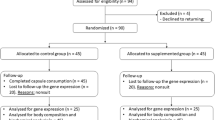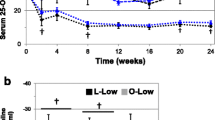Abstract
The vitamin D receptor (VDR) is crucial for virtually all of vitamin D’s actions and is thought to be ubiquitously expressed. We hypothesized that disruption of one allele of the VDR gene would impact bone development and would have metabolic consequences. Body composition and bone mass (BMD) in VDR heterozygous (VDR HET) mice were compared to those obtained in male and female VDR KO and WT mice at 8 weeks of age. Male mice were also evaluated at 16 weeks, and bone marrow mesenchymal stem cell (MSC) differentiation was evaluated in VDR female mice. Additionally, female VDR HET and WT mice received intermittent PTH treatment or vehicle (VH) for 4 weeks. BMD was determined at baseline and after treatment. MRI was done in vivo at the end of treatment; μCT and bone histomorphometry were performed after killing the animals. VDR HET male mice had normal skeletal development until 16 weeks of age but showed significantly less gain in fat mass than WT mice. In contrast, female VDR HET mice showed decreased total-body BMD at age 8 weeks but had a normal skeletal response to PTH. MSC differentiation was also impaired in VDR HET female mice. Thus, female VDR HET mice show early impairment in bone acquisition, while male VDR HET mice exhibit a lean phenotype. Our results indicate that the VDR HET mouse is a useful model for studying the metabolic and skeletal impact of decreased vitamin D sensitivity.







Similar content being viewed by others
References
DeLuca HF (2004) Overview of general physiologic features and functions of vitamin D. Am J Clin Nutr 80:1689S–1696S
Holick MF (2006) Ressurrection of vitamin D deficiency and rickets. J Clin Invest 116:2062–2072
Adams JS, Hewison M (2010) Update in vitamin D. J Clin Endocrinol Metab 95:471–478
Kuchuk NO, van Schoor NM, Pluijm SM, Chines A, Lips P (2009) Vitamin D status, parathyroid function, bone turnover and BMD in postmenopausal women with osteoporosis: global perspective. J Bone Miner Res 24:693–701
Elsammak MY, Al-Wosaibi AA, Al-Howeish A, Alsaeed J (2010) Vitamin D deficiency in Saudi Arabs. Horm Metab Res 42:364–368
Amling M, Priemel M, Holzmann T, Chapin K, Rueger JM, Baron R, Demay MB (1999) Rescue of the skeletal phenotype of vitamin D receptor–ablated mice in the setting of normal mineral ion homeostasis: formal histomorphometric and biomechanical analyses. Endocrinology 140:4982–4987
Zheng W, Xie Y, Li G, Kong J, Feng JQ, Li YC (2004) Critical role of calbindin-D28 k in calcium homeostasis revealed by mice lacking both vitamin D receptor and calbindin-D28 k. J Biol Chem 279:52406–52413
Bouillon R, Carmeliet G, Verlinden L, van Etten E, Verstuyf A, Luderer HF, Lieben L, Mathieu C, Demay M (2008) Vitamin D and human health: lessons from vitamin D receptor null mice. Endocr Rev 29:726–776
Verstuyf A, Carmeliet G, Bouillon R, Mathieu C (2010) Vitamin D: a pleiotropic hormone. Kidney Int 78:140–145
Gallagher JC, Sai AJ (2010) Vitamin D insufficiency, deficiency and bone health. J Clin Endocrinol Metab 95:2630–2633
Stechschulte SA, Kirsner RS, Federman DG (2009) Vitamin D: bone and beyond, rationale and recommendations for supplementation. Am J Med 122:793–802
Lecka-Czernick B, Ackert-Bicknell C, Adamo L, Marmolejos V, Churchill GA, Shockley KR, Reid IR, Grey A, Rosen CJ (2007) Activation of peroxisome proliferator-activated receptor gamma (PPARgamma) by rosiglitazone suppresses components of the insulin-like growth factor regulatory system in vitro and in vivo. Endocrinology 148:903–911
Parfitt AM, Drezner MK, Glorieux FH, Kanis JA, Malluche H, Meunier PJ, Ott SM, Recker RR (1987) Bone histomorphometry: standardization of nomenclature, symbols and units. Report of the ASBMR Histomorphometry Nomenclature Committee. J Bone Miner Res 2:595–610
Bischoff-Ferrari HA, Dawson-Hughes B, Staehelin HB, Orav JE, Stuck AE, Theiler R, Wong JB, Egli A, Kiel DP, Henschkowski J (2009) Fall prevention with supplemental and active forms of vitamin D: a meta-analysis of randomised controlled trials. BMJ 339:b3692
Panda DK, Miao D, Tremblay ML, Sirois J, Farookhi R, Hendy GN, Goltzman D (2001) Targeted ablation of the 25-hydroxyvitamin D 1α-hydroxylase enzyme: evidence for skeletal, reproductive and immune dysfunction. Proc Natl Acad Sci USA 98:7498–7503
Dardenenne O, Prud’homme J, Hacking SA, Glorieux FH, St. Arnaud R (2003) Rescue of the pseudo-vitamin D deficiency rickets phenotype of CYP27B1-deficient mice by treatment with 1,25-dihydroxyvitamin D3: biochemical, histomorphometric, and biomechanical analyses. J Bone Miner Res 18:637–643
Adams JS, Hewison M (2008) Unexpected actions of vitamin D: new perspectives on the regulation of innate and adaptive immunity. Nat Clin Pract Endocrinol Metab 4:80–90
Wong KE, Szeto FL, Zhang W, Honggang Y, Kong J, Zhang Z, Sun XJ, Li YC (2009) Involvement of the vitamin D receptor in energy metabolism regulation of uncoupling proteins. Am J Physiol Endocrinol Metab 296:E820–E828
Melamed ML, Michos ED, Post W, Astor B (2008) 25-Hydroxyvitamin D levels and the risk of mortality in the general population. Arch Intern Med 168:1629–1637
Kinuta K, Tanaka H, Moriwake T, Aya K, Kato S, Seino Y (2000) Vitamin D is an important factor in estrogen biosynthesis of both female and male gonads. Endocrinology 141:1317–1324
Duncan WE, Glass AR, Wray HL (1991) Estrogen regulation of the nuclear 1,25-dihydroxyvitamin D3 receptor in rat liver and kidney. Endocrinology 129:2318–2324
Erben RG, Soegiarto DW, Weber K, Zeitz U, Lieberherr M, Gniadecki R, Möller G, Adamski J, Balling R (2002) Deletion of deoxyribonucleic acid binding domain of the vitamin D receptor abrogates genomic and nongenomic functions of vitamin D. Mol Endocrinol 16:1524–1537
Binkley N, Novotny R, Krueger D, Kawahara T, Daida YG, Lensmeyer G, Hollis BW, Drezner MK (2007) Low vitamin D status despite abundant sun exposure. J Clin Endocrinol Metab 92:2130–2135
Lips P (2001) Vitamin D deficiency and secondary hyperparathyroidism in the elderly: consequences for bone loss and fractures and therapeutic implications. Endocr Rev 22:477–501
Panda DK, Miao D, Bolivar I, Li J, Huo R, Hendy GN, Goltzman D (2004) Inactivation of the 25-hydroxyvitamin D 1alpha-hydroxylase and vitamin D receptor demonstrates independent and interdependent effects of calcium and vitamin D on skeletal and mineral homeostasis. J Biol Chem 279:16754–16766
Liel Y, Ulmer E, Shary J, Hollis BW, Bell NH (1988) Low circulating vitamin D in obesity. Calcif Tissue Int 43:199–201
Snijder MB, van Dam RM, Visser M, Deeg DJ, Dekker JM, Bouter LM, Seidell JC, Lips P (2005) Adiposity in relation to vitamin D status and parathyroid hormone levels: a population-based study in older men and women. J Clin Endocrinol Metab 90:4119–4123
de Luis DA, Pacheco D, Izaola O, Terroba MC, Cuellar L, Martin T (2008) Clinical results and nutritional consequences of biliopancreatic diversion: three years of follow up. Am Nutr Metab 53:234–239
Pereira FA, Castro JAS, Santos JE, Foss MC, Paula FJ (2007) Impact of marked weight loss induced by bariatric surgery on bone mineral density and remodeling. Braz J Med Biol Res 40:509–517
Jin J, Robinson AV, Hallowell PT, Jasper JJ, Stellato TA, Wilhem SM (2007) Increases in parathyroid hormone after gastric bypass appear to be of secondary nature. Surgery 142:914–920
Narvaez CJ, Matthews D, Broun E, Chan M, Welsh J (2009) Lean phenotype and resistance to diet-induced obesity in vitamin D receptor knockout mice correlates with induction of uncoupling protein-1 in white adipose tissue. Endocrinology 150:651–661
Hey H, Stokholm KH, Lund B, Lund B, Sørensen OH (1982) Vitamin D deficiency in obese patients and changes in circulating vitamin D metabolites following jejunoileal bypass. Int J Obes 6:473–479
Zemel MB, Kim JH, Woychik RP, Michaud EJ, Kadwell SH, Patel IR, Wilkison WO (1995) Agouti regulation of intracellular calcium: role in the insulin resistance of viable yellow mice. Proc Natl Acad Sci USA 92:4733–4737
Shi H, Norman AW, Okamura WH, Sen A, Zemel MB (2002) 1α,25-Dihydroxyvitamin D3 inhibits uncoupling protein 2 expression in human adipocytes. J FASEB 16:1808–1810
Holmén J, Jansson A, Larsson DA (2009) kinetic overview of the receptors involved in 1,25-dihydroxyvitamin D3 and 24,25-dihydroxyvitamin D3 signaling: a systems biology approach. Crit Rev Eukaryot Gene Expr 19:181–196
Acknowledgments
We thank Terry M. Handerson and Marilena Preda for technical assistance in μCT and MRI exams, respectively. F. J. A. P. received financial support from the National Council for Scientific and Technological Development (CNPq), Brazil (201650/2008-8). I. D.-P. received financial support from CAPES, Brazil (0102-09-1).
Author information
Authors and Affiliations
Corresponding author
Additional information
The authors have stated that they have no conflict of interest.
Rights and permissions
About this article
Cite this article
de Paula, F.J.A., Dick-de-Paula, I., Bornstein, S. et al. VDR Haploinsufficiency Impacts Body Composition and Skeletal Acquisition in a Gender-Specific Manner. Calcif Tissue Int 89, 179–191 (2011). https://doi.org/10.1007/s00223-011-9505-1
Received:
Accepted:
Published:
Issue Date:
DOI: https://doi.org/10.1007/s00223-011-9505-1




